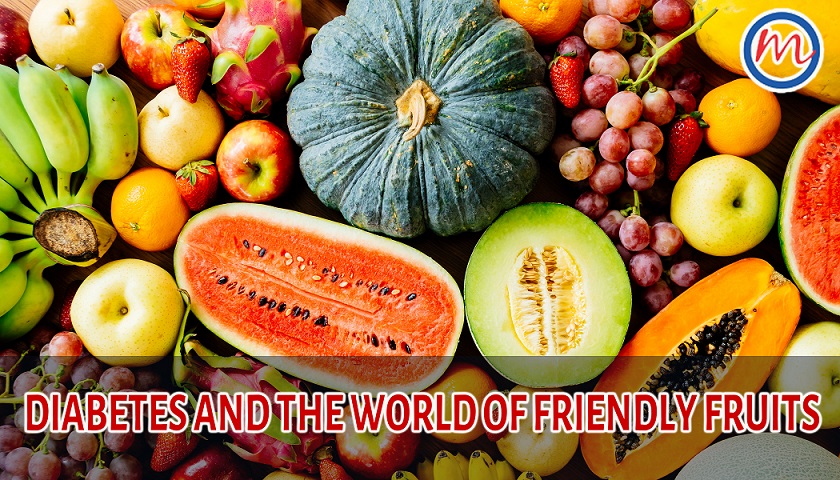Diabetes Friendly Fruits
Are fruits a taboo or are they or safe for people with diabetes? The science regarding this has swung widely for years. New research is now offering a fresh perspective. In a two-part series, we decode the concepts at work as well as feature the fruits you can have without fear
There is a sobering—if not depressing—warning that everybody with diabetes gets to hear now and then: avoid fruits. Why? The reasons cited are many: They can contain an awful lot of sugar, shoot up your blood glucose and make you gain weight. People with diabetes, watch out for fruits, these messages warn.
Fruits, however, pack good nutrition in every bite. Brimming with a wealth of vitamins, minerals and antioxidants, they keep us healthy and active. Packed with fibre (roughage), fruits keep us full for longer, feeds the good bacteria in our intestines and takes care of our digestive health. Shunning fruits also means foregoing all that goodness. What should you do?
In this two-part series on diabetes and fruits, we first decode the key concepts and issues at work, so that you can make smart, informed choices. In Part II, we focus on some choicest fruits and discuss why they can become a part of your diet. Just remember that moderation is the mantra in diabetes. Be cautious and consult your doctor whenever you need to.
ENIGMA OF FRUIT SUGAR
Fruits contain natural sugar, but it’s not the ubiquitous glucose. Fruits contain a different kind of sugar, fructose, along with some glucose and sucrose. Unlike the latter, fructose causes a lower and slower rise in blood sugar levels, as it needs to be converted into glucose by the liver before it can be used by the body. Therefore, doctors often recommend fructose as a “safe” sweetener for people with type 2 diabetes.
Fructose, however, does not suit everyone. When consumed in large amounts, fructose can have negative metabolic effects. A case in point is the high-fructose corn syrup (HFCS), used as added sugar in sweetened snacks by food-makers. HFCS has been shown to drive inflammation, obesity, diabetes, heart disease and cancer. Excess fructose is also linked to the harmful compounds, Advanced Glycation End Products (AGEs), implicated in cell ageing and degeneration.
New research has now confirmed the unexpected, that fructose from added sugars is bad for you, fruits are not. Whole fruits have unprocessed and far less sugar and calories than sweetened snacks. HFCS is a highly-processed blend of sugars derived from corn. People with diabetes are advised to avoid HFCS, the common sweetener in sodas, fruit juices, canned fruits and fruit blends.
NO OVEREATING FRUITS
Fructose is believed to be harmful in large amounts. What makes fruits a good option for people with diabetes is that it is difficult to get excessive amounts of fructose from fruits. Loaded with fibre, water and nutrients, fruits also have significant chewing resistance. It is hard to overeat fruits. One would have to eat very large amounts to reach harmful levels of fructose.
Fruits make you feel quite full and less inclined to eat more food. They take a while to eat and digest. The fructose hits the liver slowly and in small amounts, so your body is well adapted to easily metabolize the fructose. When you drink soda, the fructose hits your liver fast and in large amounts, with adverse health effects over time. Fruits are called “nature’s fast food,” because they are convenient to carry, prepare and eat.
BREAKING DOWN CARBS
When people eat a food containing carbohydrates, the digestive system breaks it down into sugar. As it enters the bloodstream, what impacts blood sugar levels the most is the quantum of carbohydrates. Whether it comes from starch or sugar is less significant.
For instance, a slice of bread, one small chapatti, a small cup of yogurt, a small banana, a small apple, a glass of orange juice, about 20 green grapes, three teaspoons of sugar or honey, a cup of milk, ⅓ cup of cooked rice, ½ cup lentils or pulses—each would be measured as one serving (or 15 grams) of carbohydrates. The effect on your blood sugar would be the same whatever you eat, so long the serving size contains 15 grams of carbs.
Fruits vary in their carb content. Low-carb fruits would include berries (kala jamun or amla), cantaloupe (kharbuja) guava, apple, oranges, sweet lime, lemon etc. Mangoes, grapes, peaches, jack fruit, watermelons and pineapple are high-carb fruits.
THE GLYCEMIC MEASURE
The word glycemic refers to the presence of glucose in blood. Normally, the level of glucose in the blood rises a small amount after eating, even in people who do not have diabetes. In most cases, the rise is barely noticeable. In people with diabetes, however, there can be rapid and sharp spikes soon after eating, followed by a steep crash. Several spikes and crashes a day, day after day, can put you at the risk of long-term diabetes complications.
Glycemic Response is the effect of food on blood sugar (glucose) levels. Glycemic Index measures how quickly a food raises blood sugar levels after meals: the lower the GI number, the less dramatically the food affects blood sugar. In general, ripe fruits tend to have a higher glycemic index than unripened fruits. Glycemic Load refers to the total glycemic load which is the glycemic index of the food multiplied by the amount of the food consumed. Glycemic Management is the selection of foods to manage your blood sugar levels. Recent research shows that calculating GL provides a more accurate picture of what a food does to blood sugar.
CALORIES, FIBRES AND PORTION
For people with diabetes, the calorie count, the amount of fibre as well as the actual serving size form the triad that should be taken cognisance of when choosing a fruit. A calorie is a unit that is used to measure the energy content present in foods. The body derives energy from diet, to perform daily tasks. Although each individual needs calories depending on age, gender, size and activity level, regular intake of high-calorie food can lead to overweight and illness. Fruits high in carbohydrate are also high in calories. For instance, banana, mango, etc.
It is best to opt for fruits with higher fibre counts always. Fibre, or roughage, is something the body can’t break down. They pass through your digestive tract undigested, slow down the rate of digestion and cause a more gradual and lower rise in blood sugar. They keep the digestive system clean, easing bowel movements and flushing cholesterol and harmful carcinogens out. Fibre also help you feel full faster. And because they are chewy, you would be less likely to overeat. Typical high-fibre fruits are: guava, jamun, pomegranate, pears, oranges and apples. Have the whole fruit, as much as possible, with the peels, skins and seeds.
Since moderation is key for people with diabetes, think about the serving size, so you don’t overeat. Here is an average serving list: for small base-ball sized fruits, like an apple, one serving would mean a single fruit. One serving of berries would fill up 3/4 of a cup. Half a big-sized banana would be a serving. For dried fruits, about 1/4 cup would suffice. About 15 grapes would make one serving.




